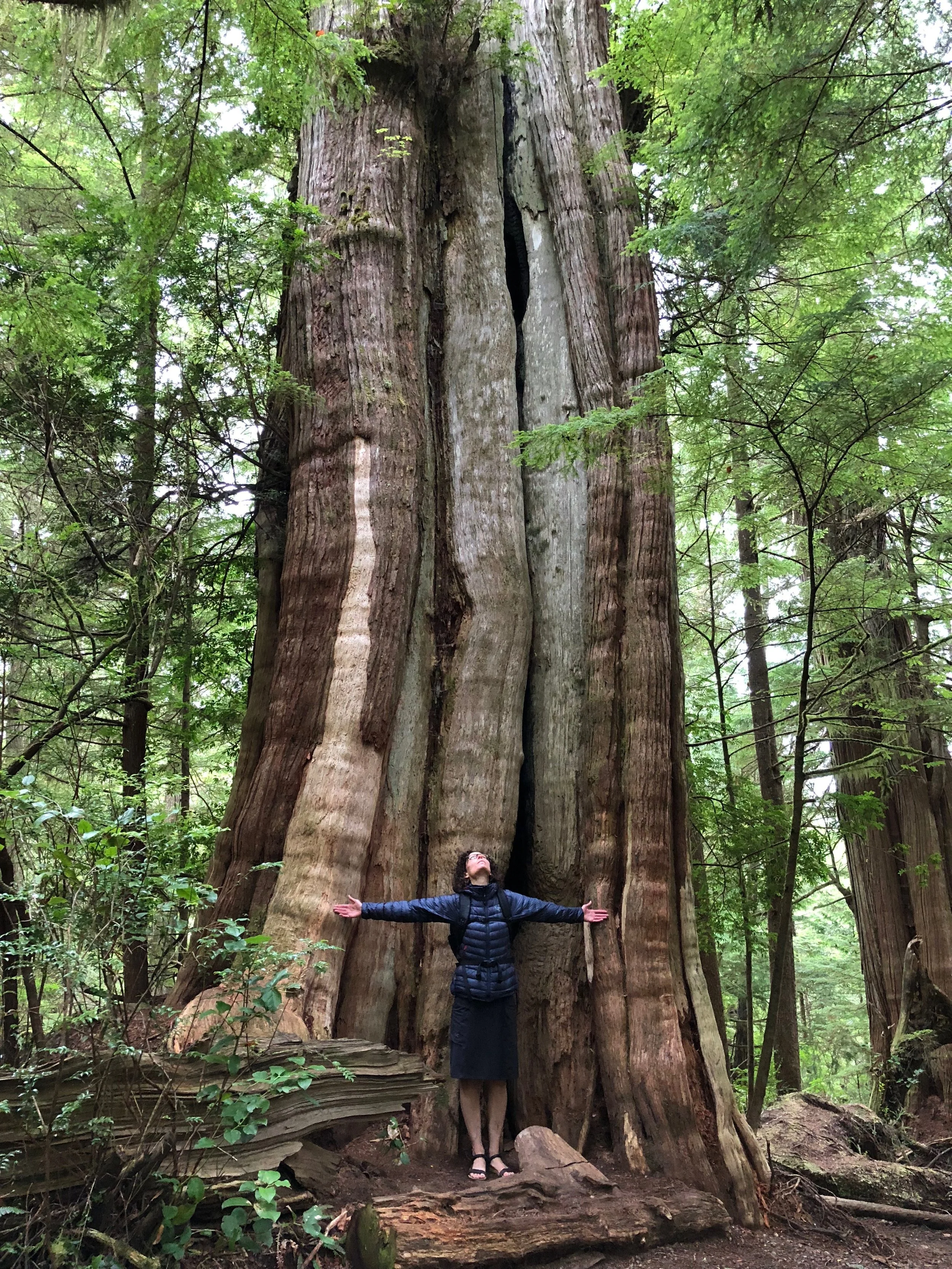What's all the fuss about cedar?
The wooden stunts that dot the trails of Vancouver’s North Shore are most frequently built from western redcedar (Thuja plicata). An evergreen coniferous tree, and the official tree of British Columbia, redcedar can live for over a 1000 years. The oldest redcedar in Canada is estimated to be 2500 years old and is still growing.(1) Trees can grow upwards of 60 m tall with trunk diameters 4 m wide or more. It grows abundantly in the Pacific Northwest, but it’s not just its availability that contributes to its popularity with local trail builders.
Western redcedar has a unique property that makes it ideal for building the wood features that made the North Shore famous. The heartwood of mature trees produces natural fungicides, including the chemical thujaplicin.(2) These chemicals protect the wood from fungus and rot and make it the perfect choice for surviving in the local wet climate. Even a century after falling, the wood of old growth cedars often remains preserved and suitable for use.(3) Neither western hemlock nor Douglas fir, frequent companions of western redcedar, share this rot resistance.
The mechanical properties of redcedar also make it a highly desirable material for trail features. Light weight but strong, it is also comparatively flexible; tending to bend rather than snap.(4) And who doesn’t love its aromatic scent!
How to Identify Cedar
The bark is “stringy” and typically peels off in long strips. Tree branches droop down with a slight upwards curl at their tips.
The leaves look like tiny braids and fan out in opposite pairs.
Cedar has a long legacy in British Columbia and is the most widely used plant by the Coastal First Nations. Xpey’ in the Hul'q’umi'num language, it is often referred to as the “tree of life”. According to legend, a very long time ago, a man in his community cared for the people, providing shelter or food when they needed help, giving away his own belongings. The Creator observed the man’s kindness and when the man died, he caused the redcedar to grow in the man’s place, so that the tree would provide for the people as the man had done.(5) Cedar plays utilitarian, creative, and sacred roles in the traditions of the Coastal First Nations. For these communities, everything is connected to cedar. From functional uses, to a medium for art, to the centre of spiritual beliefs and practices, cedar is part of all aspects of daily living.(6) Before harvesting the bark or felling a tree, the harvester would give thanks to the tree’s spirit.(5)
Every part of the cedar has value. Roots are woven into baskets. Bark is also used for weaving or may be shredded and processed to make fabric for clothing.(7) Withes, long slender flexible branches, are twisted into strong ropes. The trunk provides planks for the construction of homes and other buildings.(8) Bentwood boxes are formed by steaming a single plank of cedar and bending it into the shape of a box, with the ends of the plank pegged together to secure it. Made in a variety of sizes, then carved and painted, the boxes are used to store food, clothing, drums, and more.(9) Whole logs are carved into canoes.(10) Tools are fashioned from the lumber. Cedar is also burned for cooking and smoking food. Cedar poles are intricately carved with the likenesses of animals and humans. The carvings may document a family’s history, commemorate an event, or serve as a welcome to visitors. Some First Nations incorporated the carved poles as doorways to a home or as structural supports in a building while others erected the carvings as stand alone poles.(11) Boughs are used for cleansing and smudging rituals.
The next time you’re out on the trail, find a cedar, and take a moment to thank it for all that it gives to us.
“I would say to people, to just find a big cedar tree or a little grove that you’re comfortable with, and just go and sit under it for a couple of hours a week, and you’ll start finding yourself becoming more and more rooted to your community.”
Herb Rice, Coast Salish Master Wood Carver
Notes & References
Multi-Century Cedars: Canada's Largest, Oldest Trees | Vancouver Island Big Trees https://youtu.be/Xw2Im8nSOdg
Daniels, C.R. and J.H. Russell. Analysis of Western Redcedar (Thuja plicata Donn) Heartwood Components by HPLC as a Possible Screening Tool for Trees with Enhanced Natural Durability. Journal of Chromatographic Science, Vol. 45, May/June 2007.
The Tree Book | BC Ministry of Forests, Lands, and Natural Resources Operations
American Red Western Cedar (Giant Arborvitae) Wood | MAT Web Material Property Data
Note: Compared to both western hemlock and Douglas fir, western redcedar has a lower modulus of elasticity (stiffness). Its ultimate tensile strength is higher than that of Douglas fir though less than that of western hemlock.Stewart, H. Cedar: Tree of Life to the Northwest Coast Indian. Douglas & McIntyre Ltd, Vancouver B.C. 1984
The Story of Cedar, Cedar Hat Weaving, & Bark Pulling Cowichan Coast Salish (video) | Narrator: Herb Rice. Producer: Louise McMurray. Director, Filmographer, Editor: Phil Ives. Cowichan Aboriginal Film Festival
Cedar | Indigenous Foundations (First Nations and Indigenous Studies, University of British Columbia)
Note: Cedar bark is harvested from live trees with care taken to ensure the tree remains healthy. Planks, like bark, can also be also harvested from live trees (though whole trees were also felled for lumber). Live cedars that had bark or planks removed, are called Culturally Modified Trees, and those created prior to 1846 are protected under the British Columbia Heritage Conservation Act.The Story of Cedar (video) | Sechelt Arts Fest 2015
Native Bentwood Boxes and Bowls | Spirits of the West Coast Art Gallery
Northwest Canoes | Bill Reid Centre, Simon Fraser University
Totem Poles | Bill Reid Centre, Simon Fraser University



